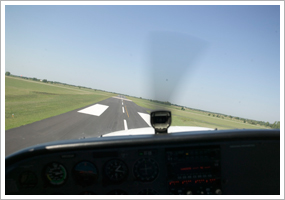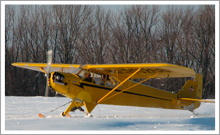| ||||
| | FT News | INSIDE AOPA | TRAINING PRODUCTS | FINAL EXAM | |||
TRAINING TIPsDemonstrated crosswind velocity
A working definition of the term comes from the Feb. 27, 2004, “Training Tip” on calculating crosswind components: "One manufacturer defines this as ‘the velocity of the crosswind component of which adequate control of the airplane during takeoff and landing was actually demonstrated during certification tests.’ Although it is not an operating limitation, it deserves your respect; new pilots and especially students should not try to test it.”
The observation that maximum demonstrated crosswind velocity is not an operating limitation is the most commonly recited fact about the number, which for a 1977 Cessna 150 Commuter is 13 knots. Indeed, the number typically appears among performance criteria, not limitations, in pilot’s operating handbooks.
Well, the designated examiner might ask, what does that mean? Should you just ignore it? Of course not. Here’s what AOPA Air Safety Foundation President Bruce Landsberg said about demonstrated crosswind velocity in the July 2000 AOPA Flight Training article “Charting the wind”: “The numbers are usually fairly high. For example, the Cessna Turbo 210 was tested to land safely in 21 knots of direct crosswind. For most of us, that will probably suffice on a day-to-day basis, and the majority of CFIs recommend that demonstrated crosswind be considered the aircraft's limit.”
One little-known fact is how the demonstrated crosswind velocity standards are satisfied during aircraft-certification tests. You’ll impress your examiner by providing this information from Chapter 10 of the Pilot’s Handbook of Aeronautical Knowledge : “Every aircraft is tested according to FAA regulations prior to certification. The aircraft is tested by a pilot with average piloting skills in 90-degree crosswinds with a velocity up to 0.2 V so or two-tenths of the aircraft’s stalling speed with power off, gear down, and flaps down. This means that if the stalling speed of the aircraft is 45 knots, it must be capable of landing in a 9-knot, 90-degree crosswind. The maximum demonstrated crosswind component is published in the AFM/POH.”
In context, the maximum demonstrated crosswind velocity is a meaningful number to know! YOUR PARTNER IN TRAININGOne of the great benefits of AOPA membership is the ability to find all kinds of preflight information quickly and easily through the Web site. And one of the most critical pieces of information—temporary flight restrictions—should be checked as close to the flight as possible because the restrictions change often. TFRs are issued for things such as natural disasters, presidential movements, and airshows. Check them out online for a quick and easy look at what’s come up since your call to flight service.
Student pilots who join AOPA are three times more likely to complete their flight training. Membership includes unlimited access to aviation information by phone (800/USA-AOPA, weekdays from 8:30 a.m. to 6 p.m. Eastern time) or from AOPA Flight Training Online or AOPA Online. If you’re not already a member, join today and get the pilot’s edge. Login information is available online. FLIGHT TRAINING NEWSCessna adds new pilot centersCessna Aircraft’s worldwide network of more than 260 pilot centers has grown. The company recently announced seven new locations: Air Associates of Missouri in St. Louis; Fly Carolina in Rock Hill, S.C.; FreeFlight CDVA in Lokeren, Belgium; Gulf Air Center in Gulf Shores, Ala.; Gunner Aviation in Rancho Murieta, Calif.; Phoenix East Aviation in Daytona Beach, Fla.; and Premier Flight Training in North Las Vegas, Nev. Cessna Pilot Centers are flight training affiliates that use the new Cessna Flight Training System and Cessna aircraft and offer customers an array of services, including flight training. More information is available online. Mass. flight school has an app for thatNorwood Flight Academy in Boston is using an iSite—a site formatted for the iPhone Web browser—to keep its customers and potential flight students engaged. The site includes general aviation and school-specific news as well as student accomplishments and an e-mail contact form. The school said it plans to add a Twitter feed and the ability to purchase a gift certificate through the site. SAFE forms safety committeeThe Society of Aviation and Flight Educators recently announced it is forming a flight training safety committee. The committee was formed to deal with what SAFE calls lagging safety standards when compared to the rest of the industry. Initially the committee hopes to adapt established programs for flight training, including a safety audit program, a safety management system for flight training operations, wider use of the General Aviation Flight Data Monitoring System, and development of a program for upset recovery for all pilots. Knowledge test fee set to increase March 1Computer Assisted Testing Service Inc. (CATS) and LaserGrade are scheduled to increase their FAA knowledge test fee by $50 on March 1. The two companies had notified AOPA that the fee increase would go into effect April 1, but a letter to testing centers indicated March 1. The companies have decided to go ahead and increase the fees at the beginning of March. Read more >> inside aopaBecome a sectional expertEvery pilot needs to learn how to use a sectional chart during training. But what do all those symbols mean? The roads, rivers, and lakes are easy to spot, but what about terminal radar service areas and ultralight fields? These are just some of the items you can learn about and quiz yourself on in the AOPA Air Safety Foundation’s newest quiz, “ VFR Sectional Review.” The quiz, which is underwritten by the AOPA Insurance Agency, is a great way to test your knowledge if you’re just learning about charts, or even if you've been flying for awhile. Check it out, along with all the foundation’s other quizzes. CFIs: Protect yourself and your livelihoodAs a CFI you can be held liable for incidents of your students, even if you weren’t on board the aircraft at the time. This startling fact makes having the right insurance policy a necessity. The AOPA Insurance Agency understands that your needs as a CFI are unique and that without the right policy you could be putting your livelihood on the line. When you get your CFI non-owned policy through the AOPA Insurance Agency, you can rest assured that you are personally protected during flight instruction. Read more >> TRAINING PRODUCTS‘21st Century Flight Training’Since we’re now 10 years into the new millennium, it seems to be time for a book on training in this century. Author and instructor Sean Lane tackles the idea in his new book, “21st Century Flight Training.” Lane covers the basic maneuvers that you’ll find in almost any aviation text, but he tries to go beyond that with a more mind-based approach. He includes heavy references to aeronautical decision making and something he calls integrated sensory flying. It’s a good reference for anyone looking for just a little bit more out of his or her textbook. You can order it for $29.95 from Aviation Supplies & Academics.
Note: Products listed have not been evaluated by ePilot editors unless otherwise noted. AOPA assumes no responsibility for products or services listed or for claims or actions by manufacturers or vendors. FINAL EXAMQuestion: I am a student pilot and I was listening to some other pilots talk about recent trips they had taken. One mentioned an airport that he flew into recently that had a very narrow runway. He mentioned something about runway width illusions. What was he talking about?
Answer: There are a couple of runway width illusions that a pilot can encounter. One is associated with a runway that is narrower than usual. This situation can create the illusion that the aircraft is higher above the ground than it actually is. If the pilot doesn’t recognize it, a lower approach might be flown, thereby increasing the risk of striking obstacles along the approach path or of landing short. A runway that is wider than usual can create the opposite illusion, causing a pilot to flare too high and land hard or even overshoot the runway. You’ll find more information on illusions in flight in the Aeronautical Information Manual, Chapter 8-1-5.
Got a question for our technical services staff? E-mail [email protected] or call the Pilot Information Center, 800/872-2672. Don’t forget the online archive of “Final Exam” questions and answers, searchable by keyword or topic. Picture Perfect
AVIATION EVENTS & WEATHER To submit an event or to search all events in the calendar, visit AOPA Online. For airport details, including FBO fuel prices, see AOPA’s Airport Directory Online. Flight Instructor Refresher ClinicsThe next AOPA Air Safety Foundation Flight Instructor Refresher Clinics are scheduled in Orlando, Fla., March 6 and 7; San Mateo, Calif., and Baltimore, Md., March 13 and 14; Ontario, Calif., March 20 and 21; Phoenix, Ariz., King of Prussia, Pa., and Virginia Beach, Va., March 27 and 28; San Diego, Calif., Cincinnati, Ohio, and Ashburn, Va., April 10 and 11; Denver, Colo., Boston, Mass., and Salt Lake City, Utah, April 17 and 18; Tampa, Fla., Atlanta, Ga., and Indianapolis, Ind., April 24 and 25. For a complete schedule, see AOPA Online.
Can’t make it in person? Sign up for the CFI Refresher Online. If you’ve never taken the CFI Refresher Online before, find out how easy it is by trying the free introductory lesson made available by the AOPA Air Safety Foundation and Jeppesen. AOPA Air Safety Foundation Safety SeminarsAOPA Air Safety Foundation Safety Seminars are scheduled in Rochester, Minn., March 8; Cedar Rapids, Iowa, and Portland, Ore., March 9; Seattle, Wash., and Olathe, Kan., March 10; Bedford, Mass., March 15; Ypsilanti, Mich., March 22; Birmingham, Ala., Northbrook, Ill., and Cleveland, Ohio, March 23; Marietta, Ga., Bolingbrook, Ill., Gaithersburg, Md., and Columbus, Ohio, March 24; Rockford, Ill., and Indianapolis, Ind., March 25; Brooklyn Center, Minn., March 29; Clayton, Mo., and Pittsburgh, Pa., April 5; Springfield, Mo., and New Cumberland, Pa., April 6; Allentown, Pa., April 7; King of Prussia, Pa., April 8; Lynchburg, Va., April 13. Topics vary—for details and a complete schedule, see AOPA Online. | Got news? Contact ePilot. Having difficulty using this service? Visit the ePilot Frequently Asked Questions now at AOPA Online or write to [email protected]. |
| Member Tools : Send feedback | Update member profile | Change email address | Unsubscribe | ePilot Archive Editorial Team: ePilot Flight Training Editor : Ian Twombly | ePilot Editor: Sarah Brown | Contributor: Alton Marsh |

 Let’s continue with our recent review of aeronautical terminology intended to help you prepare for an FAA knowledge or practical test. Here is another aircraft performance value that you might be asked to explain and interpret: your aircraft’s maximum demonstrated crosswind velocity.
Let’s continue with our recent review of aeronautical terminology intended to help you prepare for an FAA knowledge or practical test. Here is another aircraft performance value that you might be asked to explain and interpret: your aircraft’s maximum demonstrated crosswind velocity.

